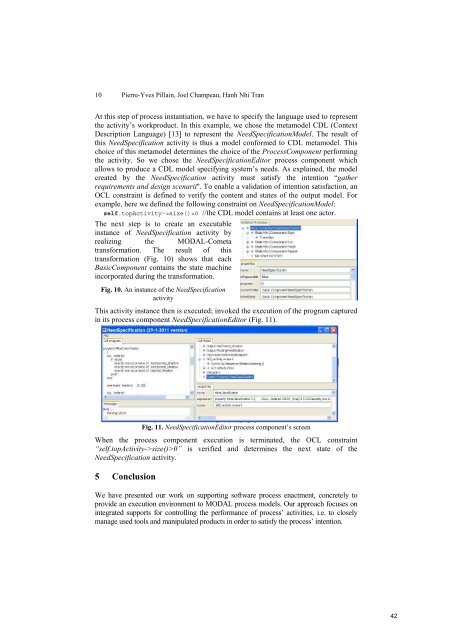A Framework for Integrating ESL Tools - IRIT
A Framework for Integrating ESL Tools - IRIT
A Framework for Integrating ESL Tools - IRIT
You also want an ePaper? Increase the reach of your titles
YUMPU automatically turns print PDFs into web optimized ePapers that Google loves.
10 Pierre-Yves Pillain, Joel Champeau, Hanh Nhi Tran<br />
At this step of process instantiation, we have to specify the language used to represent<br />
the activity’s workproduct. In this example, we chose the metamodel CDL (Context<br />
Description Language) [13] to represent the NeedSpecificationModel. The result of<br />
this NeedSpecification activity is thus a model con<strong>for</strong>med to CDL metamodel. This<br />
choice of this metamodel determines the choice of the ProcessComponent per<strong>for</strong>ming<br />
the activity. So we chose the NeedSpecificationEditor process component which<br />
allows to produce a CDL model specifying system’s needs. As explained, the model<br />
created by the NeedSpecification activity must satisfy the intention “gather<br />
requirements and design scenarii''. To enable a validation of intention satisfaction, an<br />
OCL constraint is defined to verify the content and states of the output model. For<br />
example, here we defined the following constraint on NeedSpecificationModel:<br />
self.topActivity->size()>0 //the CDL model contains at least one actor.<br />
The next step is to create an executable<br />
instance of NeedSpecification activity by<br />
realizing the MODAL-Cometa<br />
trans<strong>for</strong>mation. The result of this<br />
trans<strong>for</strong>mation (Fig. 10) shows that each<br />
BasicComponent contains the state machine<br />
incorporated during the trans<strong>for</strong>mation.<br />
Fig. 10. An instance of the NeedSpecification<br />
activity<br />
This activity instance then is executed; invoked the execution of the program captured<br />
in its process component NeedSpecificationEditor (Fig. 11).<br />
Fig. 11. NeedSpecificationEditor process component’s screen<br />
When the process component execution is terminated, the OCL constraint<br />
“self.topActivity->size()>0” is verified and determines the next state of the<br />
NeedSpecification activity.<br />
5 Conclusion<br />
We have presented our work on supporting software process enactment, concretely to<br />
provide an execution environment to MODAL process models. Our approach focuses on<br />
integrated supports <strong>for</strong> controlling the per<strong>for</strong>mance of process’ activities, i.e. to closely<br />
manage used tools and manipulated products in order to satisfy the process’ intention.<br />
42

















